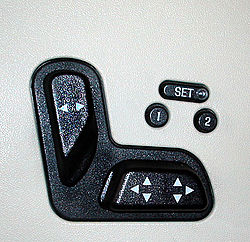
A car seat is a seat used in automobiles. Most car seats are made from inexpensive but durable material in order to withstand prolonged use. The most common material is polyester.[ citation needed ]

A car seat is a seat used in automobiles. Most car seats are made from inexpensive but durable material in order to withstand prolonged use. The most common material is polyester.[ citation needed ]


A bucket seat is a separate seat with a contoured platform designed to accommodate one person, distinct from a bench seat that is a flat platform designed to seat up to three people. Individual bucket seats typically have rounded backs and may offer a variety of adjustments to fit different passengers.

Early touring cars featured folding auxiliary seats to offer additional passenger capacity. [1] Some early automobiles were available with an exterior rumble seat that folded open into an upholstered seat for one or two passengers.
Some vehicle models offer fold-down rear seats, to gain cargo space when they are not occupied by passengers.
A fold-down front-passenger seat was a feature on the Chrysler PT Cruiser to fit longer items such as a 240-centimetre (8 ft) ladder inside the vehicle. [2]
The lumbar is the region of the spine between the diaphragm and the pelvis; it supports the most weight and is the most flexible. The adjustable lumbar mechanisms in seats allow the user to change the seat back shape in this region, to make it more comfortable and include adjustable lumbar cushion. Some seats are long enough to support full thigh and follow back curves.
The National Traffic and Motor Vehicle Safety Act enacted by the U.S. in 1966 established standards of strength for automobile seats. [3] These included requirements for proper anchorage and construction of automobile vehicle seat assemblies. [4] The legal requirements in some jurisdictions [5] for a child to sit up front is 150 cm (5 ft) and they must weigh more than 36 kg (80 lb). Some studies have shown that drivers have an aversion towards carrying the full capacity number of passengers due to concerns over insufficient vision through the back window. [6]
Side airbags are often built right into the outer edge of the seatback. Seats so equipped should not be covered which impedes the operation of the airbag. [10]

Some car seat systems are set up with a battery-powered automatic control to adjust how the seat sits in the car.
In suitably equipped cars, seats and mirrors can be adjusted using electric controls. Some vehicles let the driver(s) save the adjustments in memory (memory seat) for later recall, with the push of a button. Most systems allow users to store more than one set of adjustments. This allows multiple drivers to store their comfort settings, or a single driver to store several different occupant positions. Some vehicles associate memorized settings with a specifically numbered, remotely operated key fob, resetting a seat to the position associated with that fob when the vehicle is unlocked (e.g. key fob #1 sets seats to memory position #1, #2 to #2, etc.).
Car seat covers are accessories that protect the original seat upholstery from wear and add a custom look to a vehicle's interior. They can help to maintain the resale value [11] of the vehicle and maximize the comfort of the driver and passengers.
Some vehicles includes the option of seat climate control (i.e. heating by seat warmers or cooling) and ventilation. Ventilation was introduced in 1997 by Saab and heating by Cadillac in 1966. In 2023 BMW pulled out of a plan to implement a subscription model on their heated seats due to public backlash. [12]